4 RESULTS AND DISCUSSIONS
4.1 Relocation
experience in Ubumwe cell
The undergoing implementation process of the master plan
suggests either on site-upgrading and/or urban renewal planning i.e.
resettlement in some areas depending on how badly they are affected or how
important they are, for other developmental activities. Implementation of the
master plan started with zoning of some parts of Kigali city especially those
on prime land but poorly developed areas.
Among the zoned areas for renewal is Ubumwe cell, in Muhima
sector, in Nyarugenge district ( part of the central business district) of
Kigali city whose land will be predominantly commercial, mixed with high-rise
residential and institutions according to the master plan, as opposed to the
existed informal settlement (figure 1). Residents of Ubumwe cell were
expropriated and resettled in Batsinda housing estate in Kinyinya sector
(Gasabo district). In Ubumwe cell, 336 households were expropriated. Adoption
of the master plan happened to be the origin of Batsinda project which was
started by Kigali city council in collaboration with the Rwanda social security
board (RSSB) and Rwanda Housing Bank to handle the resettlement process and
develop the land which was taken to be a waste land due to informal settlements
in the area.
Figure 3: Image of Ubumwe site before
clearance
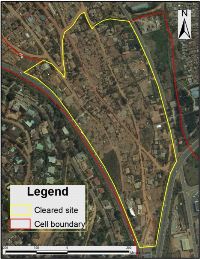
Source: RNRA/lands and mapping department
Batsinda housing project was (still is) targeting low, medium,
and high-cost housing, $10,000 being the maximum for low-cost and$30,000 being
the maximum for medium-cost. The first phase established 250 single-family,
low-cost homes and this was finished with people already relocated into
Batsinda houses from Ubumwe cell. However, only 123 former Ubumwe dwellers
accepted to be relocated out of 250 Batsinda phase I houses (49%), the
remaining 127 houses were given to other vulnerable groups like soldiers,
demobilized soldiers and teachers due to their low income level (Esther,
2009).
The cleared site of Ubumwe cell is now being serviced by
providing roads, street lamps and other basic physical infrastructures (photo
1). Some buildings are being raised while other plots are still vacant. This
redevelopment seems to be slow since there are now 3 years after the relocation
of the residents on that site. According to one of the sector officials in
charge of infrastructure and land management, the redevelopment is relatively
slow because the parcels are very expensive. But the city council says that the
parcels are expensive because of the great expenditures made in servicing land
and providing infrastructures
Photograph 1:Current situation of
the cleared site of Ubumwe
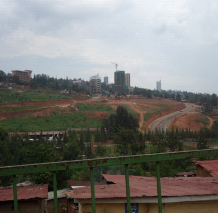
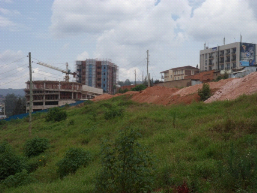
Source: taken by author, October 2011
4.2 Existing
situation of Amahoro cell
4.2.1 Nature of housing
Houses in Amahoro cell are generally characterized by high
density, old roofs and are built with unsustainable materials.
Parcels in this area are very small to the extent that in most
cases the house occupies the whole parcel space with no room for extension,
improvement or for other domestic purposes. Most parcels were acquired before
1990 (65%) and most houses were constructed during this period. Another massive
acquisition of the parcels and construction of new houses occurred between 1995
and 2000 (refer to table 4).
This was the period of the aftermath of genocide and
liberation war during which Rwandese refugees that had fled the country since
1959 and years after, returned to their mother land and had to acquire vacant
land for their establishment since most of them were born and grew in exile and
had no land in the country. The acquisition of land parcels occurred illegally
without prior planning, and in most cases involved dividing the existed land
parcels without respecting minimum parcel size hence creating a slum. Since
2006, the rate of acquiring new parcels in the area and construction of new
houses is very low. This is due to the establishment of the new policies (land
policy, 2005 and Kigali master plan, 2007) that restrict further illegal
housing development.
Table 4: Periods of plot acquisition in surveyed
households
|
Question
|
Response
|
Frequency
|
Percentage
|
|
When was the plot acquired?
|
1960-1970
|
2
|
3.5
|
|
1971-1980
|
21
|
37
|
|
1981-1990
|
14
|
24.5
|
|
1991-1994
|
2
|
3.5
|
|
1995-2000
|
13
|
22.8
|
|
2001-2005
|
3
|
5.2
|
|
2006-2011
|
2
|
3.5
|
|
Total
|
57
|
100
|
Source: survey, 2011
N.B only 57 households responded to this question out of
100 that were asked
Building materials of the houses are unsustainable and old.
The roofing materials (100% iron sheet) have changed their original color due
to rust as a result of long time exposure to elements of rusting without
replacement. Most iron sheets disintegrated and the owners use stones or other
high-density materials to support them (see photo 2).
Photograph 2: Stones supporting
old iron sheets
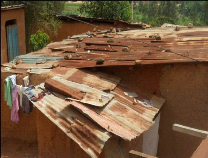
Source: Author, 2011
Walls of most houses are built in mud bricks (53%), 28% in
earth and wattle, 15% in burnt bricks and the remaining 4% in cemented blocks
(figure 5).
Figure 4: Type of building materials of walls of
houses
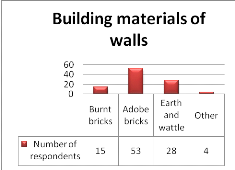
Source: Household survey
2011
According to the regulations of Kigali city council, no house
upgrading that involves changing its shape and size that can be made without
written authorization from the relevant officials at the district. This,
together with poverty, has restricted upgrading by some residents and their
houses are wearing out and slowly falling down (photo 3).
Photograph 3: A house gradually
falling down
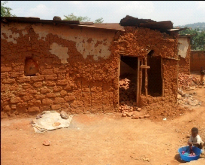
Source: Author, 2011
| 


